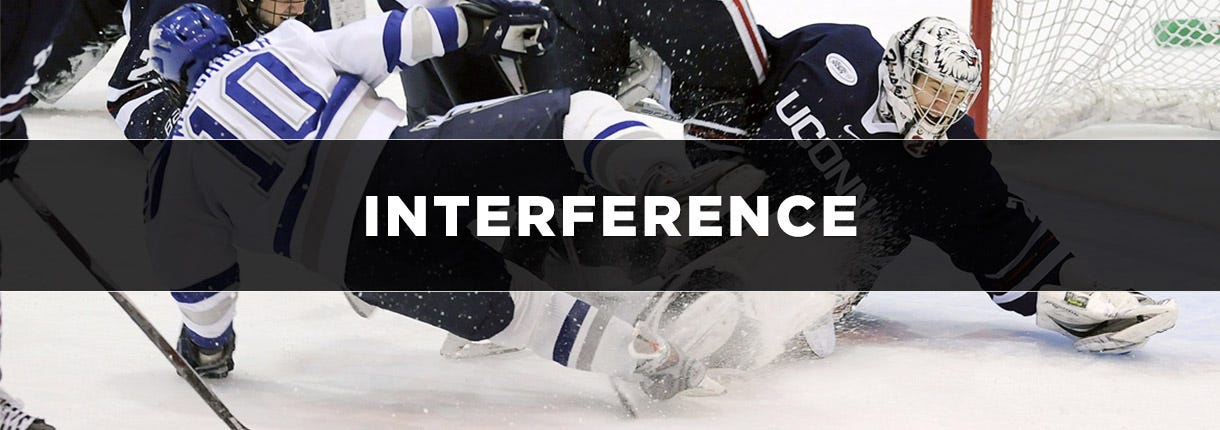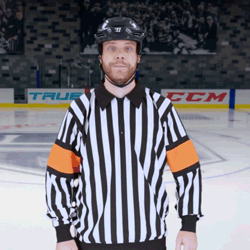Goalie Interference in Hockey: Explanation and NHL Rules

By definition, Goalie Interference in hockey is a penalty called when an opposing player initiates contact with the goalie, whether intentionally or unintentionally, and therefore impairing the goalie’s ability to move freely.
Furthermore, this penalty can be called whether the goalie is inside or outside of the goal crease. However, if an opposing player is pushed into the goalie, while he is in his crease, by one of the goalie’s teammates, then it will typically not be called a penalty. This is at the discretion of the referee.
Keep yourself protected by browsing our website for a wide variety of hockey equipment!
- Video Example of Goalie Interference
- Referee Sign
- Penalties for Goalie Interference Hockey
- The Official NHL Rule Text (Rule 69)
- Other Player Interference in Hockey
Video Example of Goalie Interference
The play in the video above is a good example of Goaltender Interference. As the shot comes in from the Jet’s right defenseman, the Jets centerman, #85 can be seen skating right towards the opposing goaltender. Right before the puck gets to the net, #85’s elbow briefly contacts the Ducks goaltender’s head.
This elbow stuns the goalie and causes him to fall over, thus not being able to make a play on the puck. The referee determined it to be Goaltender Interference before the puck went in, hence the no-goal call on the play.
Furthermore, the referee determined that #85 made no reasonable effort to avoid the contact, while the Goaltender was in the crease, therefore resulting in a two-minute Minor Penalty.
Referee Sign

The referee crosses both arms to form an “X” motion in front of the chest. Both hands clenched in fists.
Penalties for Goalie Interference Hockey
In all cases in which an attacking player initiates intentional or deliberate contact with a goalkeeper, whether or not the goalkeeper is inside or outside the goal crease, and whether or not a goal is scored, the attacking player will receive a penalty. In most instances, the referee will call a two-minute Minor Penalty for Goalie Interference but can also call a five-minute Major Penalty depending on the severity of the situation.
The Official NHL Rule Text (Rule 69)
This rule is based on the premise that an attacking player’s position, whether inside or outside the crease, should not, by itself, determine whether a goal should be allowed or disallowed. In other words, goals scored while attacking players are standing in the crease may, in appropriate circumstances be allowed. Goals should be disallowed only if: (1) an attacking player, either by his positioning or by contact, impairs the goalkeeper’s ability to move freely within his crease or defend his goal; or (2) an attacking player initiates intentional or deliberate contact with a goalkeeper, inside or outside of his goal crease. Incidental contact with a goalkeeper will be permitted, and resulting goals allowed, when such contact is initiated outside of the goal crease, provided the attacking player has made a reasonable effort to avoid such contact. The rule will be enforced exclusively in accordance with the on-ice judgment of the Referee(s) but may be subject to a Coach’s Challenge (see Rule 38).
For purposes of this rule, “contact,” whether incidental or otherwise, shall mean any contact that is made between or among a goalkeeper and attacking player(s), whether by means of a stick or any part of the body.
The overriding rationale of this rule is that a goalkeeper should have the ability to move freely within his goal crease without being hindered by the actions of an attacking player. If an attacking player enters the goal crease and, by his actions, impairs the goalkeeper’s ability to defend his goal, and a goal is scored, the goal will be disallowed.
If an attacking player has been pushed, shoved, or fouled by a defending player so as to cause him to come into contact with the goalkeeper, such contact will not be deemed contact initiated by the attacking player for purposes of this rule, provided the attacking player has made a reasonable effort to avoid such contact.
If a defending player has been pushed, shoved, or fouled by an attacking player so as to cause the defending player to come into contact with his own goalkeeper, such contact shall be deemed contact initiated by the attacking player for purposes of this rule, and if necessary a penalty assessed to the attacking player and if a goal is scored it would be disallowed.
Other Player Interference in Hockey
Interference Penalties can also be called against a player who makes contact with an opposing skater. In short, an Interference Penalty will be called if a player is illegally impeding the progress of an opposing player (non-puck carrier), with no intention of making a play on the puck. This will almost always result in a two-minute Minor Penalty but can be called a five-minute Major Penalty at the discretion of the referee.
The actions listed below will warrant an Interference Penalty:
- Providing a protective screen and limiting the opportunity for an opposing player to apply pressure to a teammate in possession and control of the puck.
- Making no attempt to play the puck while facing-off and instead plays the body of the opponent.
- An attacking player who no longer has possession and control of the puck initiates contact with the defending player in an effort to obstruct their ability to play the puck or an opponent.
- A defending player who changes his skating lane or foot speed in an effort to play the body of an opponent who is no longer in possession and control of the puck.
- Deliberately knocking the stick out of an opponent’s hand.
- Preventing an opponent who has dropped his stick or any other piece of equipment from retrieving it.
- Shooting, throwing or directing any object (equipment, broken stick, etc.) that may be on the ice in the direction of an opponent in an attempt to distract him.
- Any player who makes physical contact, using his stick or body, in a manner that interferes with the movement of the goalkeeper, unless otherwise specified in the rules.
- Any player on the players’ or penalty bench who interferes, in any manner, with the movement of the puck or any opponent on the ice while play is in progress.











